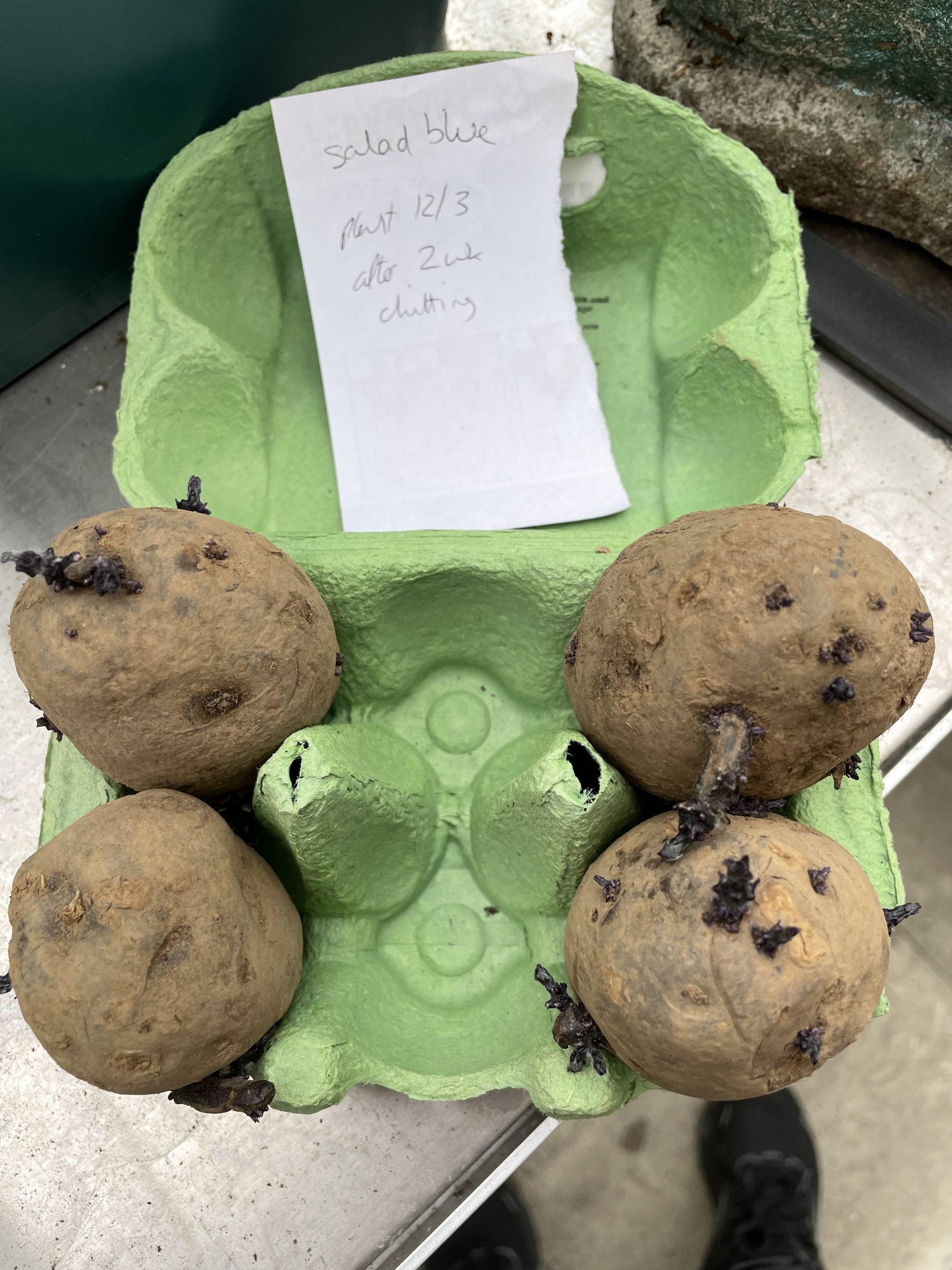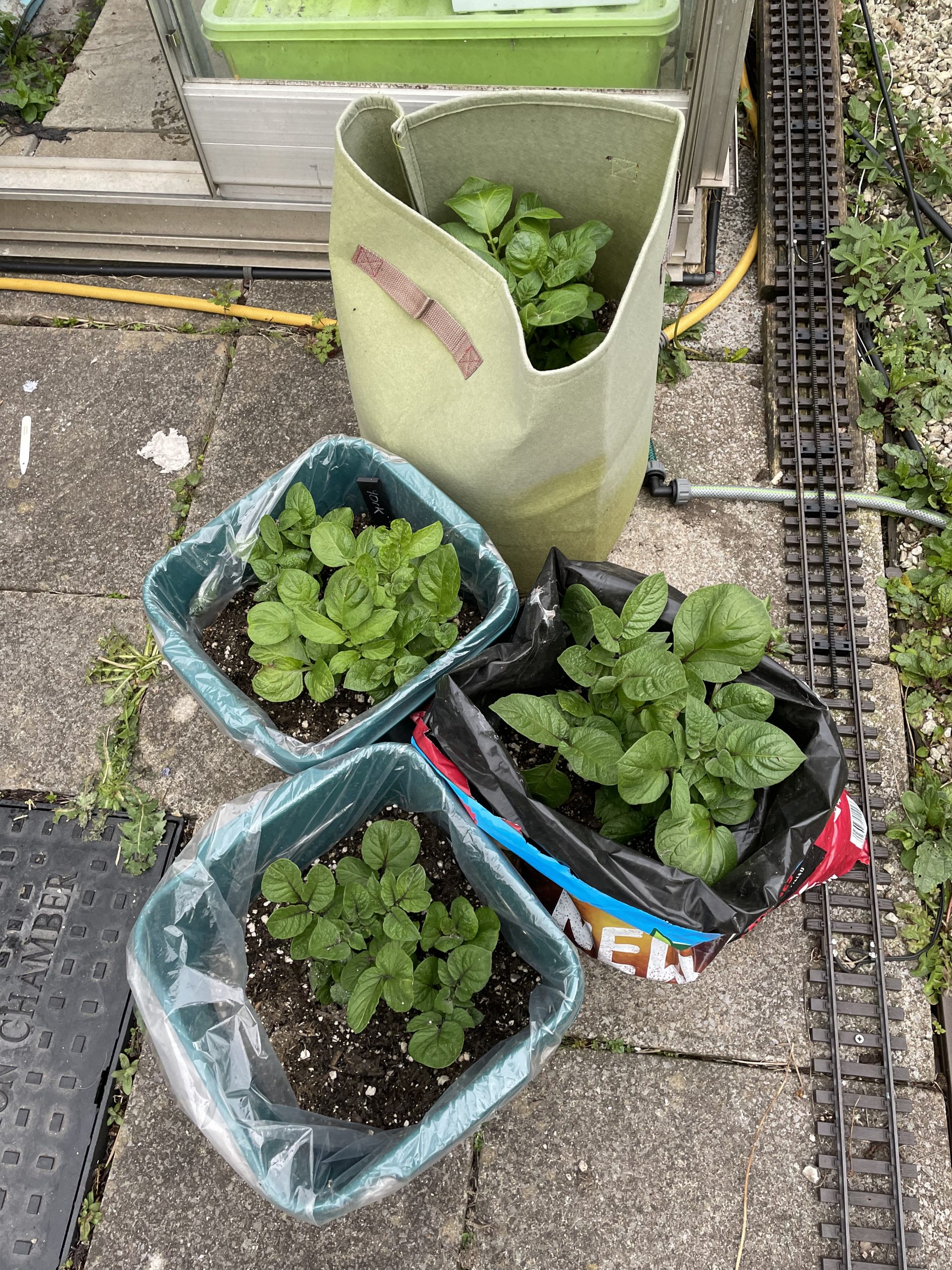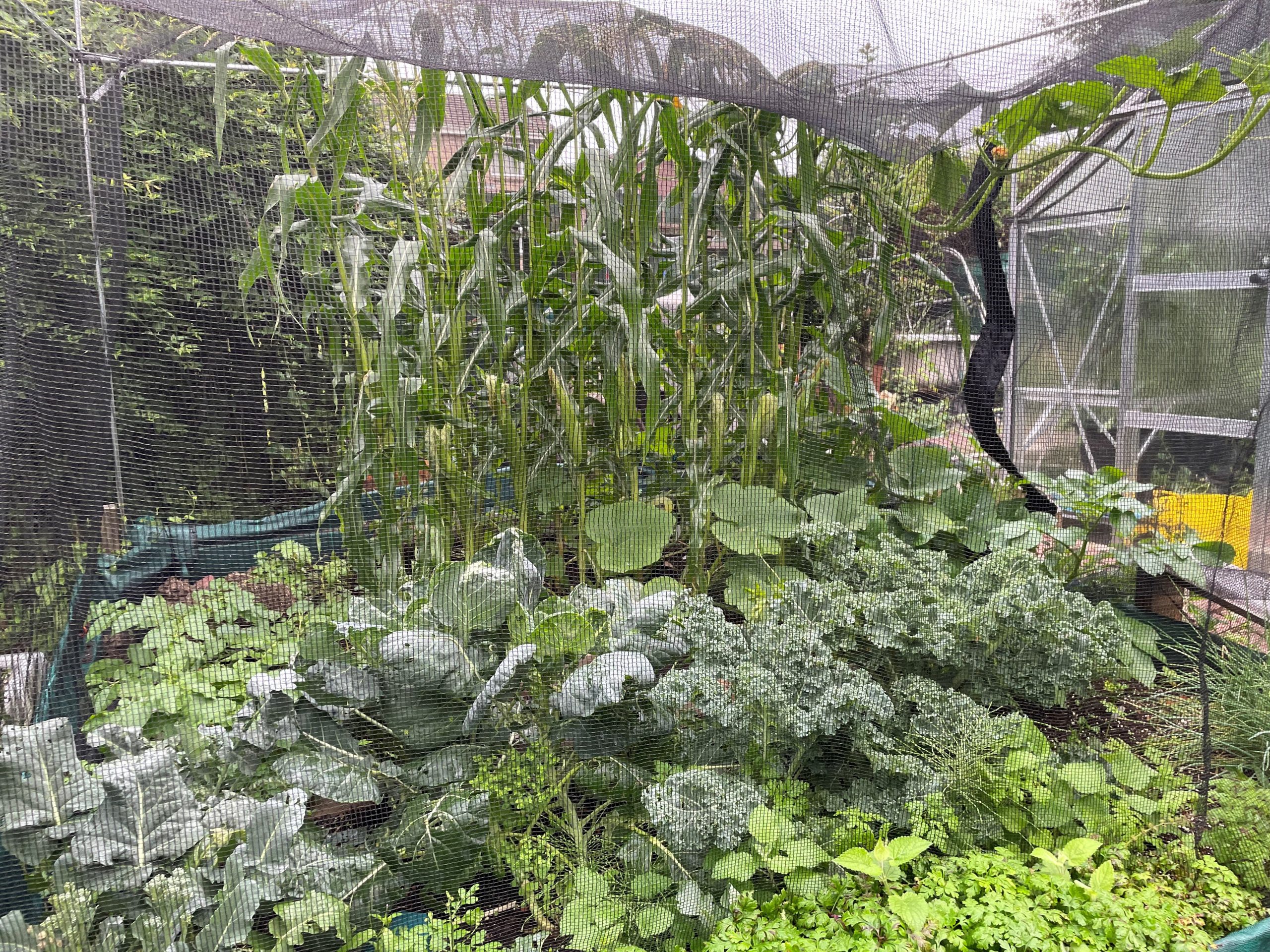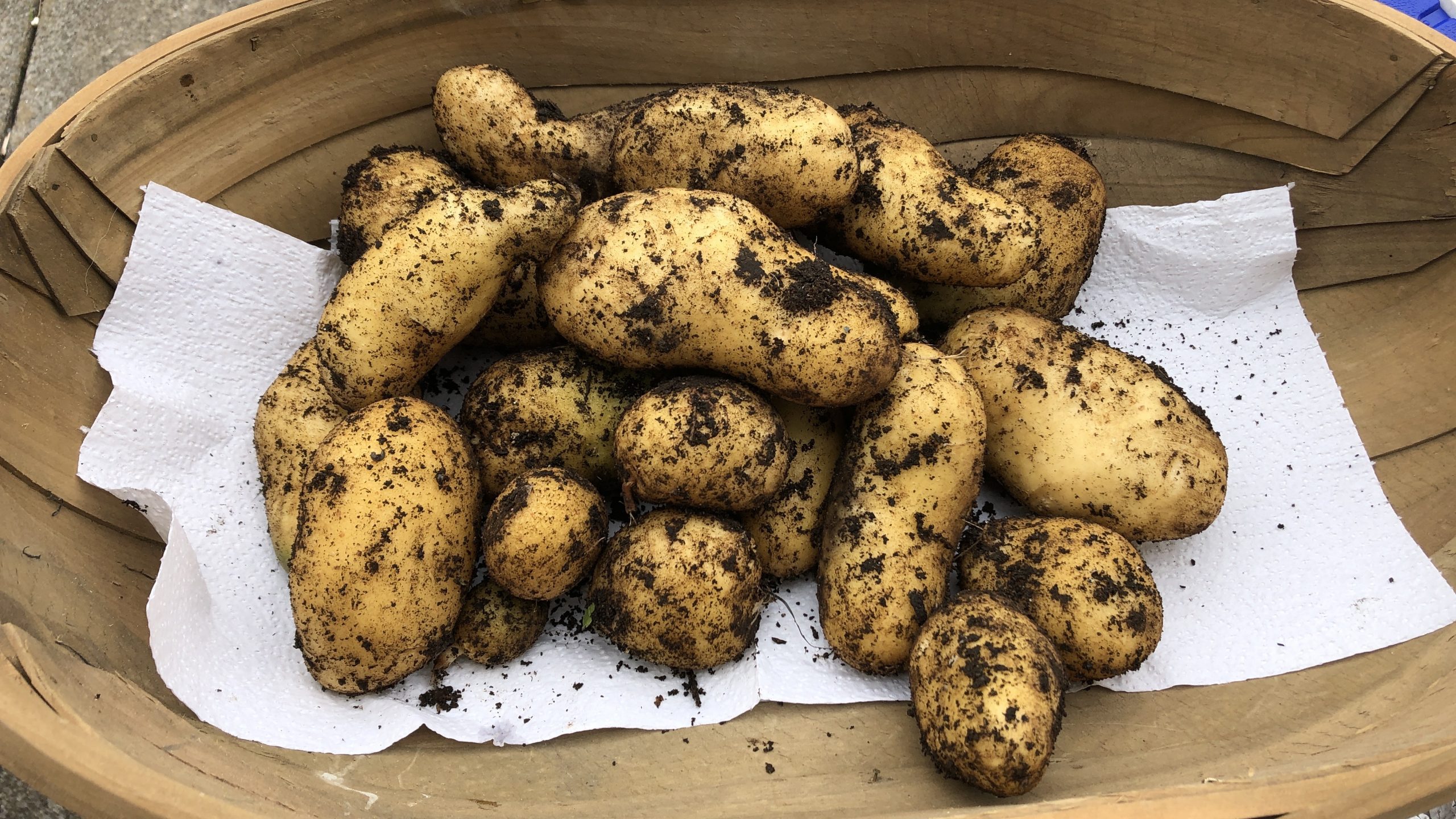Potatoes
8 September 2023Potatoes are well known as a culinary mainstay in several cultures (starting with the Incas from 8000BC) which is probably because there’s so many ways of cooking them! The nutritional value of potatoes varies a bit depending on how recently they’ve been harvested – new potatoes have a different range of available micronutrients compared to ordinary potatoes. However, the bigger impact on nutritional value comes from how they are prepared – surprisingly cooking potatoes and allowing them to cool afterwards increases the “resistant starch” content which has many of the same benefits as fibre. Of course, the major benefit of growing your own potatoes is avoiding the processed varieties available in the shops which (although convenient) have nutritional hazards like fat and sodium added.
The UK is a great climate for growing potatoes! Surprisingly (for such a small area), UK is the 11th highest producer of potatoes in the world! There are also a huge number of varieties which can be planted!
Choosing potatoes to grow
When purchasing potatoes you will normally find them categorised related to when they can be harvested:
- First early – generally harvested in June/July
- Second early – generally harvested in July/August
- Early Maincrop – generally harvested in August
- Late Maincrop – generally harvested September to October
- Second dropping/late cropping – ready September to December.
Of course, another deciding factor is the texture (waxy or floury) and the way you plan to cook them. Waxy potatoes tend to be best for boiling, while many people prefer floury potatoes for roasting.
Issues
The great enemy of the potato is blight (caused by a fungus) in humid summers and is infamous for its role in the great famine in Ireland starting in 1845. Blight attacks normally start in July or August, so one of the easiest ways of avoiding blight issues is to grow “early” potatoes; however, these are not so good for storing over winter. The conditions which cause blight are temperatures above 10oC for 2 consecutive days with Relative Humidity above 90% for 11 hours in each of those days (known as a Hutton period). Blightspy can help forecast these periods, allowing plants to be checked and any affected foliage removed (and burned) before the entire plant and soil is infected. If the soil becomes infected its best to avoid growing potatoes for a few years. This approach also helps reduce issues with potato cyst eelworm and ties in with generally avoiding growing crops in the same place in consecutive years. If blight is a real problem in your area, it’s worth taking a look at the “SARPO” varieties which have been bred to resist potato blight. A third common problem is potato scab which can be reduced by keeping the soil at Ph 5.5 and adding more organic matter.
Growing in small spaces
From a combination of the potatoes which I like and concerns about blight, I’ve tended to grow Charlotte potatoes (2nd early). The process starts with “chitting” (be careful of your pronunciation to avoid offense!). This just means leaving the seed potatoes in daylight so that the roots can start to develop (usually less than 2 weeks)

Make sure you avoid any frost pockets when choosing the position for planting early varieties! Then plant the potatoes with just a shallow covering of soil or compost. Once the plants have grown to about 20cm high, make sure they are covered so only 5cm show above the soil or compost. If growing in containers this is usually done by adding compost. Earthing up ensures that the tubers are protected from daylight to prevent them turning green. The toxic chemical solanine is indicated by the green colouration, so green potatoes should not be eaten.

Seed potatoes tend to be sold in quite large quantities (bags of 20). As I only have a small space, I’ve swapped with friends, which has given me a chance to try some other varieties too! These have included Duke of York (1st early), Marfona (2nd early), Salad Blue (maincrop) and Vale Sovereign (maincrop).
As I grow a range of plants together, one of my main issues with potatoes is finding all the tubers! As a result, my crop efficiency for growing these in the vegetable patch is fairly poor. However, having a range of plants growing together increases the overall crop efficiency of the space and helps confuse pests.

The flipside of failing to find some of the tubers is that I’ve had several unexpected crops when last year’s tubers have sprouted as new plants. This will be frowned on by gardeners who know that we’re supposed to get all the potatoes out of the ground as another precaution to reduce blight though. I’ve tried out a few different options on growing potatoes in containers. These have included potato towers, potato pots with removable insert, cheap felt potato bags and reusing compost bags after piercing a few drainage holes in the base. From the harvest data below, you can find that many of my best crops have been from cheap felt bags or re-used compost bags!

I have also seen potatoes grown in a range of random containers including towers made from car tyres, so there’s lots of options for growing potatoes without buying expensive pots.
I’ve had some harvests as early as May (when I’ve had to remove unexpected plants), and I’ve also let them stay in the soil as late as October, to avoid disturbing other nearby plants. The potatoes have still tasted great but have a bit more slug damage!
Space efficiency/ Value for money
From comparing potatoes to the other crops I’ve gathered data on, it’s clear why potatoes are so popular. As long as you think ahead to avoid blight problems, you can get a great crop from a remarkably small footprint! However, as potatoes are generally cheap to buy in the shops, they’re not so great in terms of crop value for the space they take up.
| crop | year | soil area (m2) | soil depth (m) | annual harvest (kg) | mass yield (kg/ m2d) | £ yield (£/ m2d) | Calorie space* (m2) | Protein space* (m2) |
| Charlotte (reused compost bag *3) | 2020 | 0.071 | 0.2 | 1.015 | 0.1207 | 0.2255 | 55 | 51 |
| Charlotte (veg patch) | 2020 | 0.77 | 0.3 | 2.663 | 0.0290 | 0.0543 | 227 | 212 |
| Charlotte (veg patch / unexpected) | 2021 | 0.35 | 0.3 | 1.556 | 0.0236 | 0.0442 | 177 | 165 |
| Charlotte (felt bag) | 2022 | 0.071 | 0.25 | 1.143 | 0.0865 | 0.1617 | 48.5 | 45.3 |
| Charlotte (veg patch/ unexpected) | 2022 | 0.9 | 0.2 | 2.443 | 0.0207 | 0.0388 | 289 | 270 |
| Charlotte (veg patch/ unexpected) | 2022 | 0.42 | 0.15 | 1.748 | 0.0318 | 0.0594 | 189 | 176 |
| Duke of York (potato pot) | 2022 | 0.063 | 0.2 | 1.097 | 0.1596 | 0.2984 | 44.7 | 41.8 |
| Duke of York (felt bag) | 2022 | 0.071 | 0.25 | 0,278 | 0.0375 | 0.067 | 200 | 186 |
| Marfona (felt bag) | 2022 | 0.071 | 0.25 | 1.348 | 0.1020 | 0.1907 | 41.2 | 38.4 |
| Salad Blue (potato pot) | 2022 | 0.063 | 0.2 | 0.654 | 0.5596 | 0.1046 | 75 | 70 |
| Salad Blue (reused compost bag) | 2022 | 0.071 | 0.25 | 1.236 | 0.9536 | 0.1746 | 44.9 | 41.9 |
| Vale Sovereign (felt bag) | 2022 | 0.071 | 0.25 | 1.187 | 0.0898 | 0.1679 | 46.7 | 43.6 |